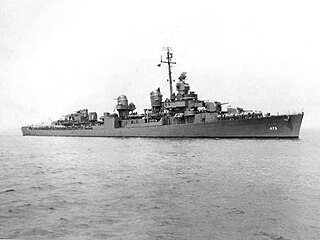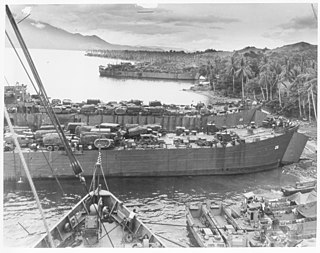Service history
During World War II, LST-19 was assigned to the Asiatic-Pacific theater. From 1–17 July 1943, she was on the California coast en route to Alaska. She stopped at San Diego, Mare Island Navy Yard and San Francisco, loading cargo and LCT-81 on her top deck, and embarking Army personnel at the latter location. On 17 July 1943, she was underway out of San Francisco Bay, arriving at the Naval Air Station, Woman's Bay, Kodiak, Alaska on 25 July 1943. On 27 July, she was underway in convoy with three Navy escorts and in company with LST-20, LST-23, LST-69, LST-169, LST-205, and LST-479 for Adak Island in the Aleutians where she arrived on 1 August 1943. Here the Army personnel were disembarked and LCT-81 launched. Beaching exercises were carried out. Practice operations were continued, some in Great Sitkin Island area and cargo was unloaded at Sweeper's Cove. Departing Adak on 14 August 1943, LST-19 took position in a convoy operating with Task Force 16.10. On 16 August, she broke off and proceeded independently, anchoring off Kiska Island. She then entered Kiska Harbor on 19 August, and began unloading Army equipment. Getting underway on 19 August, in convoy with LST-69 and LCI-77, LCI-78, LCI-79, LCI-80, LCI-81, and LCI-82, escorted by Coghlan, she began proceeding independently on 22 August, and anchored at Adak Island. She departed for San Francisco, on 31 August 1943, but turned back to Adak due to engine problems.
LST-19 was at San Pedro, on 4 April 1944. Proceeding to San Diego and San Francisco, she departed for Pearl Harbor, on 3 May 1944. Proceeding by way of Saipan and Eniwetok LST-19 arrived at Peleliu on D-1 day, 14 September 1944, and was also engaged in the raids on Volocano-Bonia and Yap. She returned to Peleliu and Angaur on 24 December 1944. On 31 December, she was at Fais Island, returning to Peleliu on 15 January 1945. LST-19 arrived at Kossol, on 4 February 1945, and Ulithi on 11 February. She departed Ulithi, on 5 March, for San Francisco via Eniwetok, Pearl Harbor, San Pedro and San Diego, arriving on 28 July 1945. On 5 August 1945, she departed San Francisco for Pearl Harbor, returning on 3 September 1945.
LST-19 was redesignated as LST(H)-19 on 15 September 1945. Again departing San Francisco, on 25 September 1945, she proceeded to Wakayama, Japan, via Pearl Harbor and Buckner Bay, Okinawa, arriving there on 5 November 1945. She returned to San Francisco, in January 1946, via Saipan and Pearl Harbor. She then sailed for Charleston, South Carolina, via the Canal Zone, on 18 January 1946, arriving at Charleston on 14 February 1946.
This page is based on this
Wikipedia article Text is available under the
CC BY-SA 4.0 license; additional terms may apply.
Images, videos and audio are available under their respective licenses.
















